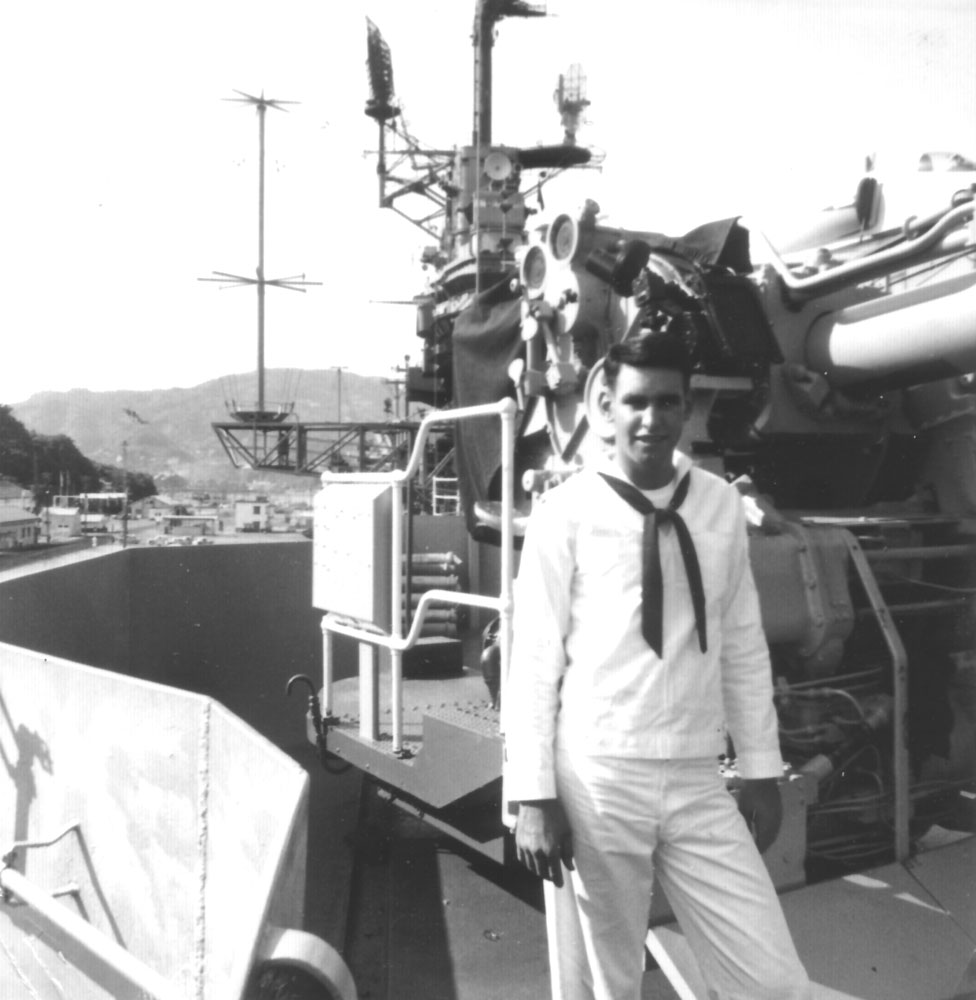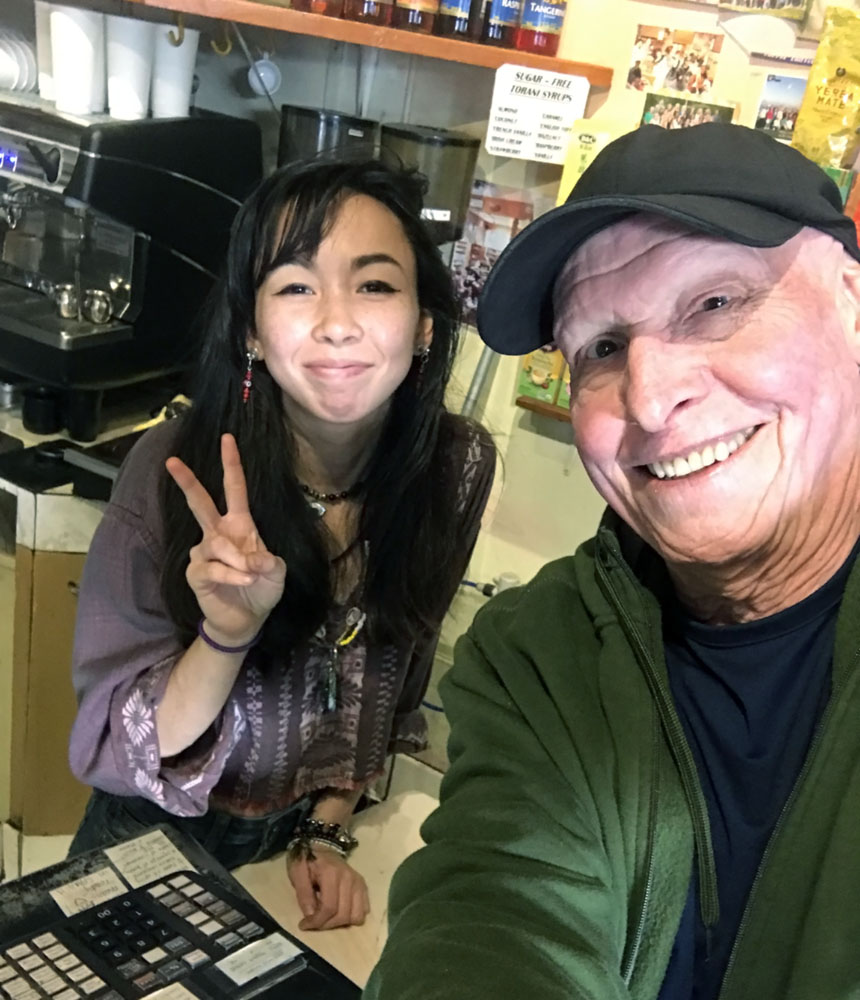 |
My Long Road to VVAWBy John EdwardsRecently I was in Coffee Cartel, a favorite hangout in Redondo Beach. Megan, a barista there, often wears pins on her vest. I had some pins marking special moments in a drawer, so one day I brought them for Megan to browse through. She asked about the VVAW/WSO pin. She is about nineteen years old. So I was surprised that she was interested in VVAW, and what I knew about it. When I was her age, I knew nothing about politics and cared even less. When I was her age I was a high school dropout swabbie on the flight deck of the USS Ticonderoga. We were in the Gulf of Tonkin. I was there for the Gulf of Tonkin Incident that triggered the Vietnam War. I was a plane handler between the catapults near the bow of the ship in V-1 Division. My friend, John Schmied, was the talker in flight deck control working the large metal Ouija board that showed positions of aircraft on the flight deck. On 2 August 1964, our destroyer escort the USS Maddox, was fired on by North Vietnamese PT Boats. Four of our F-8 Crusaders engaged them, crippling three of their boats, and killing four Vietnamese.
Two nights later, our aircraft scrambled to defend the Maddox and the USS Turner Joy, who reported they were under attack. When Commander James Stockdale, the lead VF-51 F-8 Crusader pilot returned, the flight deck control officer asked him what happened. Stockdale said our ships were firing into the dark, with no enemy ships in sight. My friend Schmied told me about overhearing that exchange. On 5 August, President Johnson ordered us to launch a large attack on North Vietnam. On 7 August, he signed the Gulf of Tonkin Resolution which gave him authority to engage the Vietnamese without declaring war. We carried nuclear bombs that were regularly loaded onto A4 Skyhawks, and we drilled for nuclear attacks. The satirical movie Dr. Strangelove was fresh in my memory. I realized then that nuclear war was not a joke. In this situation it was a real possibility. The bombs were right in front of me on the Ticonderoga. If we used nukes on Vietnam, the Chinese or Russians would surely nuke the US. Even if I even survived on the ship, the world would be changed forever. Politics suddenly became important. So as we returned to San Diego for Christmas, I bought our cruise book. It had diagrams of how the "Reds" had attacked our destroyers and how we counter attacked. Recalling 4 August it said, "Aircraft from the Ticonderoga again were immediately on the scene and joined in repelling the enemy torpedo craft. As a result of the engagement, two PT boats were reported sunk and two others damaged." The account about the second attack did not square at all with what Commander Stockdale had said. I felt betrayed that our own government would lie about such an important event, and even start a real, but undeclared war based on it. What could I do with that information? I realized I was ignorant, and decided to get educated. My enlistment ended in 1966, so I enrolled at Los Angeles Harbor College to finish high school and get a degree. The GI-Bill provided me $100 per month, which together with my part-time job income, enabled me to survive in school. In 1969, when I entered UCLA, Bruin Walk bristled with anti-war groups handing out flyers and information. I was skeptical of all of them, but I was open to reading the government's own Pentagon Papers published in 1971. I took a class about them from Tom Hayden to learn what secretly happened in Vietnam. I told him about my experience in the Gulf of Tonkin. He was the first person who had any interest in my experience. That dovetailed into his class on the Pentagon Papers—which revealed that our government had secretly pushed us into the war for years, while hiding critical information from Congress and the public. Hayden included the history of Vietnam, which for centuries fought off the Chinese, the Japanese and the French. They would never give up unless we killed everyone. Meanwhile, my younger brother, Rob, was subject to the draft, several kids I grew up with were in Vietnam and one high school friend was killed there. Putting Rob's and other friends' lives in danger for a futile and dishonestly promoted war infuriated me. If he was drafted, I planned to go for him. I knew the ropes and knew he would not survive there. I joined anti-war actions. I marched, protested and occupied the UCLA administration building with Bill Walton and others. Part of my activism included working on a film called Still At War, which was the first time I heard about VVAW. Bill Hager of VVAW was the prime mover in the film. I was honored that he gave me the VVAW button/pin that I eventually offered to Megan. Once I received my Environmental Engineering Masters, I was hired to work on the Space Shuttle program for the Air Force Space and Missile Systems Center (SMC). It felt good to work on the inside of the military to make it better environmentally. I helped them move from solid rockets to liquid rockets which significantly reduced ozone depletion. There I was invited to join the Veterans of Foreign Wars. Even though they had long ago promoted the GI-Bill, they became outdated, supported the war and required belief in God, so I decided as I am an atheist, to pass. When 9/11 hit, the deceptions took hold again, in the run up to the Iraq War. I knew it was a repeat of Vietnam, misleading the public and Congress. Signs of it were everywhere. Most notably, fifteen of the 9/11 hijackers were from Saudi Arabia, none were from Iraq as the government and news glossed over, because the narrative drive was to attack Iraq. Another example: Bush alleged Iraq was seeking nuclear weapons they would provide to Al Qaeda to attack us. In 2002, Joseph Wilson was sent to Niger to determine if Iraq was buying yellowcake uranium needed for nukes. When he reported Iraq wasn't doing so, the Bush Administration outed his wife, Valerie Plame, as a CIA agent. This was retribution for challenging the party line driving us to war with the wrong country. It was distressing that most people could not see through the Bush and Cheney hype. I wrote to my representatives to oppose the war. Barbara Boxer was not snowed by the hype but Dianne Feinstein fell for it. In 2003 on the first night of "Shock and Awe," I was in DC and felt compelled to protest in Lafayette Park with many others. Our government was starting another war based on deception. Sadly, we are still suffering the repercussions, while still at war in the Middle East. Then fast forward to when Megan asked me about VVAW, she put me on the spot! I told her what I could remember about VVAW. I didn't have answers so I went to Wikipedia, then on to the VVAW website to learn more. And I was drawn to your blunt truth, so I joined. When my copy of The Veteran arrived, I read it cover to cover. VVAW's approach seems similar to that of Thomas Paine. He was a lone voice, but his message in pamphlets like Common Sense and The Crisis and books like The Rights of Man was amplified because it so clearly and powerfully stated the facts. VVAW assembles and documents the observations of returning veterans, analyzes them, writes about them and publicizes them, first in The Winter Soldier Investigations and now in The Veteran. Like Paine, VVAW was attacked. Powerful interests did not want VVAW to speak out or be heard. Unable to refute the message, they attacked the messenger. VVAW has had the strength and perseverance to carry on all of these years, addressing the issues I've been writing about. So when I went back to Coffee Cartel in mid-pandemic, Megan was there in a mask, a working hero dealing with customers, some prattling conspiracy theories, some arguing about wearing masks. I sat outside writing an answer to VVAW's call for articles. I shared my research with Megan: VVAW's understanding, organizational memory and drive to create a just nation are needed as much, or more, now as they were during the Vietnam War. VVAW helps vets and organizes vets to help our country avoid descending into tragic, senseless wars. In these "times that try men's souls," the Winter Soldiers of VVAW are here now to support Megan's generation. John R. Edwards, USN, enlisted Jan. 1962 - May 1966 USS Ticonderoga CVA14. USAF Civilian Engineer, SMC, Oct. 1979 - Jan. 2010. He has a daughter and son.
|



